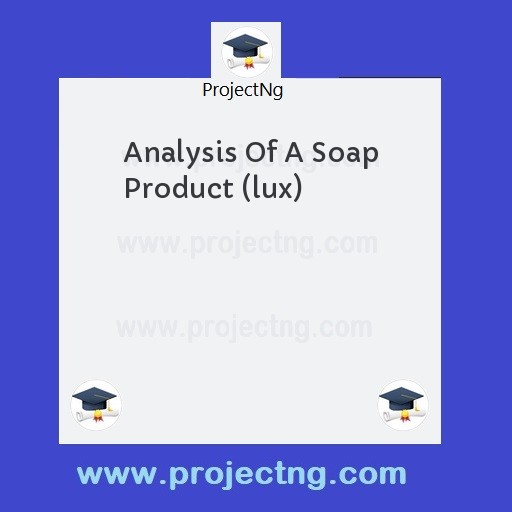Analysis Of A Soap Product (lux)
Science Lab Technology Project Topics
Get the Complete Project Materials Now! »
ANALYSIS OF A SOAP PRODUCT (LUX)
ABSTRACT
The soap that is used for the analysis is Lux. The analytical tests carried out on the soap are moisture content and free caustic alkali. For the determination of the moisture content, the materials and reagent that was used are:
i. The Porcelain dish
ii. Glass rod and
iii. Hot air oven
The reagents are:
i. The petroleum spirit and
ii. Sodium acetate
For the determination of the free caustic alkali, the material and reagent that was used are:
a) Beaker
b) Clamand Stand conical flask
c) Pipette Separating funnel
d) 95% ethanol
e) Ph enophthalein indicator
f) Barium chloride and
g) Hydrochloric acid
After the analysis, it was observed that the percentage of water content was 20%, while the free caustic alkali was 0 – 05%. Also after the analysis, it was found that soap that contains high caustic alkali will cause rashes and irritation of the skin. And the one that contain high moisture will now shrink and will not fume well. The soap (Lux) Analysed will be used for washing and general removal of dirty. It will also enhance removal of dirty. It also reduces the surface tension, and serves to remove odour and greasy surfaces.
TABLE OF CONTENTS
Title page
Certification
Dedication
Acknowledgement
Abstract
Table of contents
CHAPTER ONE
1.0 INTRODUCTION
1.1 AIM AND OBJECTIVES
1.2 STATEMENT OF THE PROBLEM
1.3 HYPOTHESIS
1.4 SIGNIFICANCE OF STUDY
1.5 LIMITATIONS
CHAPTER TWO
2.0 LITERATURE REVIEW
2.1 SCIENTIFIC PRINCIPLES RELATED TO THE PROJECT
2.2 CLEANING ACTION OF SOAPS
CHAPTER THREE
3.0 REAGENT AND MATERIALS
2.1 EQUIPMENT AND METHODS
CHAPTER FOUR
4.0 RESULTS AND DISCUSSIONS
CHAPTER FIVE
5.0 CONCLUSIONS
REFERENCES
CHAPTER ONE
1.0 INTRODUCTION
The analysis of soaps has become necessary by the desire to rationalize test procedures and thereby adequately provide, for the requirement contained in soap to make it work effectively.
Soaps are the sodium or potassium salt of long chain, fatty acids and are produced by saponification of fats and oils with alkalis e.g. potassium hydroxide.
Lux soap, which is used for bathing and laundry, for it to be satisfactory for consumpti0on, shall be free from objectionable odour both as received and in water solution; it should not contain/have any active chlorine or oxygen. It should not have any active that shall not contain any visible foreign matter posses good. Lathering and cleansing properties and should have no injurious effect on the skin. Also it should contain low water content, no impurities, and very small excess alkali.
It is made by the action of a hot caustic solution on tallow or fatty oils, with the simultaneous formation of glycerol, which at one time, was wasted or left in the soap, as it is still certain, glycerol is a valuable by product. The reaction is as follows:
![]() 3NaOH + (C17 H35 COO)3 C3H5 3 C17 H35 COONa +
3NaOH + (C17 H35 COO)3 C3H5 3 C17 H35 COONa +
Caustic Triglyceride sodium stearate
Alkali (soap)
C3H5(oH)3
Glycerol
Soap can also be made by the action of caustic soda or fatty acid without producing glycerol. The reaction is as follows:
![]() NaOH + (C17H35 COO)3C3H5 3C17H35COONa + H2O
NaOH + (C17H35 COO)3C3H5 3C17H35COONa + H2O
Caustic
Soda Stearic acid Soap Water
The NAFDAC STANDARD FOR QUALITY SOAP IS – 02 – 1526.
Be the First to Share On Social

Enjoying our content?
Don't miss out on new videos! Subscribe to our YouTube channel for more awesome content.
Subscribe Now!













